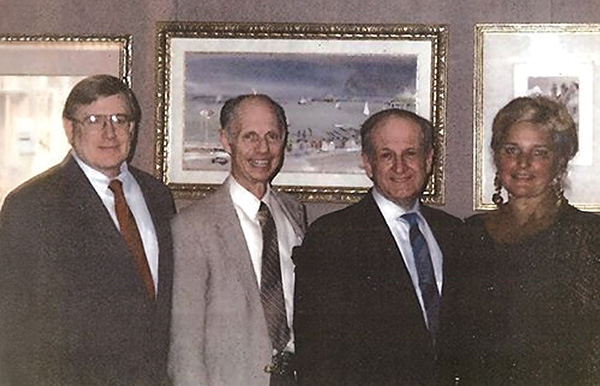You became a chiropractor to serve people, not an insurance company. You deserve to run a business that aligns with your values, supports your family and lights you up. Cash-based care isn’t just a pricing model – it’s a philosophy rooted in freedom, trust and respect for your patients and for yourself. Here's why - and how - to do it.
Honoring the Chiropractic Profession’s Heroines (Pt. 3)
- In October 1976, new practitioner Dr. Patricia Arthur took the courageous step by joining fellow plaintiffs Chester Wilk, DC, James Bryden, DC, Steven G. Lumsden, DC, and Michael Pedigo, DC, in filing a lawsuit against the American Medical Association.
- When the chiropractic profession needed her, Dr. Arthur – as a single mother of a special-needs son, and a new practitioner – boldly stepped forward to become one of the five chiropractic plaintiffs.
- The suit ultimately resulted in a ruling against the AMA for its “lengthy, systematic, successful and unlawful boycott” of the chiropractic profession.
| As discussed in part 1 of this six-part series, I am a long-time student of chiropractic history. In that regard, I have very much admired the outstanding work performed by women doctors of chiropractic. In 2021, I began an extensive effort to research and recognize the "best of the best" female DCs in the following six important categories: Licensure Pediatrics Legal Education Veterans Fervor Brief biographies for each of these chiropractic warriors are being published in this column in a series. As you read about each of these six Charter Inductees, I believe you will mumble to yourself more than once, I didn't know that. If that happens, I will have accomplished my goal. Upon of the completion of my research, I obtained a "Hall of Honor" website to recognize these Charter Inductees. I am purposely not giving out the website address yet because each of the inductees has earned her own solo announcement. |
In the 1960s, Patricia Arthur was a single mother searching to further her education. She wanted a career that would provide for her and her son. She attended the Robert Packer Hospital School of Surgical Technology to become an operating-room aide, earning her certificate in 1968. The eight-month course gave her knowledge and skills for the operating room and relevant departments in a hospital.
During this time, her son developed a chronic respiratory infection. She sought medical help from a pediatrician at the hospital. Despite persistent efforts, her son’s condition worsened. At this time, he was also diagnosed with dyslexia and minimal brain dysfunction, which meant he needed extra care and attention.
A medical doctor (MD) suggested that since her son was not responsive to medicine, perhaps she should try chiropractic. She had never been to a chiropractor before, but she was willing to try in the hope that her son would be able to live a healthier and more normal life.
She found a local chiropractor and scheduled her son to begin treatments. After eight visits, he showed remarkable improvement and no longer experienced respiratory problems. This was a relief to Patricia – and sparked her thinking about what she could do for her career.

In August 1970, she moved to Davenport, Iowa, and enrolled in the Palmer College of Chiropractic. Three-and-a-half years later, she graduated with her Doctor of Chiropractic degree. During this time, she continued to care for her disabled son. With her interest in sports medicine and love for the outdoors, she moved to Estes Park, Colo. to set up her chiropractic practice. Estes Park was a haven for outdoor enthusiasts and she wanted her son to be in a healthy environment.
In June 1975, she opened her office, securing office space, developing advertisements, and making community connections. The item she needed most was an X-ray machine. Fresh out of school, she could not afford to buy a new machine, so she searched the area to see what might be available.
The nearest chiropractor with a machine was 60 miles away, which would be too far to ask her patients to travel. What seemed the obvious choice was to contact the local hospital and set up a relationship so she could order X-rays and laboratory tests for her patients there.
Because of her training and having worked for several years in a hospital environment, she was fluent with the inner workings of a hospital, especially with hospital procedures and patient care. She was comfortable contacting the local hospital staff and approached the administrator at Elizabeth Knutsson Hospital to establish a relationship.
She spoke with several people and made friends quickly with the lab and X-ray technicians. They promised her that they would take care of anyone she sent to the hospital. However, during her first day of practice, the hospital administrator arrived at her office with some disturbing news. The hospital administrators had changed their minds; they would not allow her to refer her patients to the hospital for X-rays or lab testing.
The administrator said that she needed to submit her concern for review, which she did. The hospital sent her a letter stating that the “Joint Commission on Accreditation of Hospitals will not allow chiropractors to use hospital facilities.” The hospital was new and the administration was applying for accreditation, which meant it would be under extra scrutiny. The hospital staff was told that their accreditation would be in jeopardy if they allowed a chiropractor to use their facility. Thus, they felt that they had no other choice but to deny her request.
This meant Dr. Arthur was not able to take care of her patients safely and would not be able to run her practice under those conditions. She felt that she had no other option than to leave the area and start a new practice elsewhere.
She had spent a great deal of money to start the new practice in Estes Park. As a single mother supporting a disabled son with special education needs, she endured significant financial hardship. She began to search for help. She wrote to the American Chiropractic Association and the Colorado Chiropractic Society to see if they could assist her.
Also during this time, she read about a chiropractor who was speaking out about injustices being done to chiropractors. His name was Dr. Chester Wilk. In October 1976, and as a new practitioner, Dr. Arthur took the courageous step by joining fellow plaintiffs Chester Wilk, DC,1 James Bryden, DC,2 Steven G. Lumsden, DC, and Michael Pedigo, DC3 in filing a lawsuit against the American Medical Association. The “Wilk vs. AMA” lawsuit also named many of the nation’s other most prominent medical groups as co-defendants such as the American Hospital Association, the American College of Surgeons, the American College of Physicians, and the Joint Commission on Accreditation of Hospitals.
The lawsuit claimed that the defendants had participated for years in an illegal conspiracy to destroy chiropractic. After 11 long years, on Aug. 24, 1987, U.S. District Court Judge Susan Getzendanner ruled that the AMA and its officials were guilty, as charged, of attempting to eliminate the chiropractic profession.
Author’s Closing Observations About Dr. Arthur
While conjecture on my part, I can see my longtime friends Chet and Mike listening to legal counsel George McAndrews4 as he told them that four male plaintiffs were unacceptable and then likely saying, “We must have a bright, articulate and passionate female plaintiff.” Whether that conversation occurred or not, that is certainly what they got with Dr. Arthur!
When the chiropractic profession needed her, Dr. Arthur – as a single mother of a special-needs son, and a new practitioner – boldly stepped forward to become one of the five chiropractic plaintiffs in the historic Wilk v AMA lawsuit that resulted in the judge’s ruling against the American Medical Association for its “lengthy, systematic, successful and unlawful boycott.”
Author’s Note: Stay tuned! My next column will focus on the charter inductee in the education category. Should you have any questions, comments or suggested future inductees, contact me by email at Doctor@JamesEdwards.com.
References
- The DC Who Took on the AMA – and Won: A Moment of Silence for Dr. Chester Wilk.” Dynamic Chiropractic, May 2022. Read Here
- McAndrews G. “A Tribute to the Life of Dr. James W. Bryden.” Dynamic Chiropractic, January 2016. Read Here
- Sportelli L. “Paying Tribute to a True Leader in Chiropractic.” Dynamic Chiropractic, November 2010. Read Here
- “Farewell to Chiropractic’s Great Defender.” Dynamic Chiropractic, June 2023. Read Here



